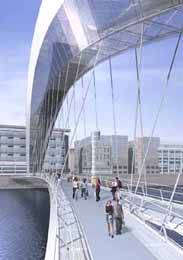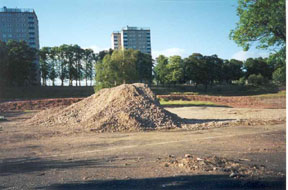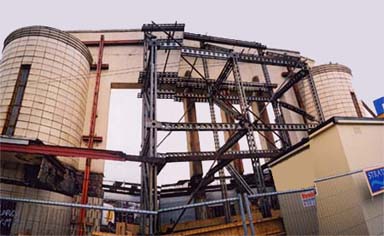![]()
![]()
An email arrived the other day from Jim Cullen of Clyde Waterfront. This organisation describes itself thus: "Clyde Waterfront is a strategic partnership of the Scottish Executive, Scottish Enterprise, Glasgow City Council, Renfrewshire Council, West Dunbartonshire Council and Communities Scotland." So it ticks all the right boxes as far as joined-up government is concerned. Their website goes on to say: "Clyde Waterfront is Scotland’s single most significant urban renewal project and development opportunity.
"With around £5.6bn of public and private sector investment Clyde Waterfront has the potential to deliver significant benefits for the entire economy. Our 15 year plan for waterfront regeneration will transform one of the world’s most famous rivers.
"Our vision is of a vibrant, thriving River Clyde. People and communities will be at its heart. "Collaboration is the key. From new housing developments in Glasgow to a range of business and leisure facilities, plans are in place to transform the area. The boost to the economy will help Scotland compete on an international stage." Which I suppose is a long-winded way of saying they're in the process of building lots of nice houses and offices for people to live and work in. And indeed, a look at their website suggests this is the case. However, I'm at a big disadvantage at the moment. I live in Washington and won't be back in Glasgow until next summer. So I'd be very grateful if readers could let me know whether all this is as good as it looks. |
220 Broomielaw: I like this |
 |
I've just learned from the excellent Glasgow Architecture site that Glasgow is to have a new bridge and that, as the result of a competition, that bridge is to be one by the grate Richard Rogers. It's on the left. Now, call me lazy, but I think the best way to get from place to place is to go in a straight line, so what on earth is this all about? Maybe he's taking the piss out of Glaswegians — we're all so pissed all the time that we can't walk in a straight line. Or maybe he just looked at Gateshead Millennium Bridge and thought "oh, something like that'll do, I suppose". The losers are below. |
|
This one's by Bednarski and does genuinely take into account one feature of Glasgow — the constant rain. What a superb place both to shelter and cross the river at the same time. |
This is by Norman Foster. It's elegant and gets you across without a huge detour. |
This is by Future Systems. You can walk straight across from a number of streets on one side to a number on the other. Brilliant. Or, if you are pissed, you can walk across at an angle. |
||
|
This is by GM+AD. A lovely, but pointless drawing.
|
 |
And this is by Lifschitz Davidson. Very strange. |
|
Regular readers will remember that Gillespie, Kidd & Coia's King's Park Secondary School was under threat from being covered with the Glasgow "architect's" answer to everything — cladding. Cordula Zeidler of The Twentieth Century Society writes with photos of what has happened. "It's a disgrace," she says. Indeed. Here's what the city council says on the schools section of its website: "The buildings were refurbished and included re-cladding, the provision of a rationalized suite of 8 ICT rooms and upgrading and rationalization of a further 15 teaching spaces including Home Economics." So training pupils to be office-fodder, able to sit in front of glowing boxes for hours on end, pressing buttons, or else cooking, is of great importance, but training them to have some awareness of aesthetics and culture isn't, it would appear. Who is responsible for this mess? According to a University of Paisley MSc thesis by Massimo Stefani, who was IT Professional Officer/Deputy Project Manager (Web Development) with Glasgow City Council until 2000: "3ED — a consortium involving the Miller Group, Amey plc and Halifax plc, with ICT partners Hewlett Packard, Mitel and Morse — were selected by the City Council as "preferred bidder" in November 1999 on the quality and cost effectiveness" of their proposals, following an exhaustive tendering process under European rules." Aha! So it's the Europeans' fault again. (Paisley University's Computer Science department was ranked 102nd in the UK in the Guardian league table.) If you'd like to read some high-quality corporate nonsense, click here for what the Miller Group have to say about their work. |
Before (above) and after (below)
|
|
St Peter's Seminary at Cardross seems to be getting a lot of visitors these days. Leon McDermott reports: "I went up to St Peter's Seminary today with my dad; he spent lots of summer holiday time in Cardross when he was a kid in the 50s, and when I told him about the Gillespie, Kidd & Coia building, he had to go and visit it. Anyway, we went up there, took lots of photos (it's amazing how the building's serene and calm characteristics still remain, despite the dereliction and the graffiti), and I did some Googling on the place when I got back home, and while I was rooting about, I found this article from the Scotsman: "During St Peter's brief heyday, film-maker Murray Grigor made a short documentary, Space and Light, about the college and will feature the ruin in the television series he is currently making with Scotland's best-known actor-in-exile, under the working title, Sean Connery's Scotland. Says Grigor: "What I'd very much like to do now is revisit the place and make a new film of it, then have the building come back to life." "Grigor regards the present situation as "absolutely tragic. It's one of the most significant buildings of the 20th century and we've got it as a ruin. It would be heroic for someone like Historic Scotland to think about restoring it. It's interesting that the Catholic Church in Scotland was so progressive and produced all these extraordinary buildings." He laughs, recalling the priest who told him that St Peter's had been built under the influence of "le Courvoisier"." The full article is at: http://www.thescotsman.co.uk/s2.cfm?id=439212003 |
As for the hints that St Peter's is going to be renovated, I can't see it, from what I saw at the weekend; everything was still woefully derelict, and it looked like it hadn't been touched in years. On the upside, almost, I'm in the middle of preparing a big post about St Peter's on the weblog that myself and a friend of mine run; I'm just waiting for the photos I took to come back from processing. The address is http://www.submitresponse.co.uk Then Leon goes and spoils it all by saying: "I'm not with you on Basil Spence's Gorbals tower blocks. Looked nice, horrible to live in, as several of my friends have attested." Jack Mottram informs us that: "me and a couple of other folk are putting together a little gallery of photos we took of St. Peter's Seminary this weekend (http://www.submitresponse.co.uk/ seminary/). Only a couple of my inept snaps with a Lomo camera are up so far, but the work of more skilled photographers, using proper cameras will be online by... well, soonish." This site inspired me to buy my own Lomo camera, it's that good. A sample is above.
|
|
Dougie Ferguson tells me that the Anderston Centre, the subject of a major project on which he is engaged, is about to disappear. Dalriada — the westerly housing block — is due to be demolished in late 2004, with the Davaar and Colombia blocks to follow soon after. There may still be time to protest — the Royal Fine Art Commission report on the Centre thinks it's worth saving — but given Glasgow's appalling record of destruction, it's likely these pictures will soon be all that's left to enjoy. |
|
|
|
G L A S G O W -+
-A R C H I T E C T U R E
Here's a lovely image from Adrian Welch's Glasgow Architecture site. He's far more up-to-date with the news than I am, so it's well worth bookmarking for regular visits. |
|
The ultimate joy of concrete Every schoolboy's dream has come true, for me at least. This is my old school, the John Neilson in Paisley, recently reduced to a pile of rubble. Pity it's several years (well, decades really) too late. |
 |
|
Regular readers will be dying to know how the redevelopment of the Art Deco cinema on Great Western Road is coming along (see story at the bottom of this page). Well, if 'redevelopment' means knocking most of it down, then swimmingly, it would appear. Two columns, a bit of arch and a huge hole in the ground are all that remain. Hope someone goes round to 'redevelop' the redevelopers houses sometime. |
 |
 |
To see how Glasgow redevelopers might tackle other projects, click here. |
|
Look at this proposed development of flats which would finally complete a row in the Park Circus area of Glasgow which the Victorians never got round to finishing. Lovely, isn't it? Not if you're Glasgow (UK City of Architecture 1999) councillors Patricia Chalmers or John Mason, Historic Scotland or one of the four heritage bodies mentioned in the Scotsman report on 1 August. Chalmers and Mason seem to think that it does not fit with rest of the area because it doesn't look Victorian. JoC would love to see if the councillors' own homes are so meticulously consistent - if Victorian, do they have gas lighting, for example. Fortunately, these fools were ignored by Ronald Davey, chairman of the development and regeneration services sub-committee, and building should begin in October. Even Davey sounded a bit lukewarm about the Stewart Milne Homes development, though, saying only that it was the best scheme available. JoC thinks it's the best scheme possible. More like this please. |
|
|
In a shocking move which is a great loss to architectural criticism, Michael Gallagher no longer has his Ugly Tour of Glasgow website (which included Tay House, the monstrosity on the left). Says Michael: "Sadly I no longer have any of the photos or files for that project. I am surprised no one else got round to finishing of the idea fully." So, come on readers. Send in your best/worst pictures of Glaswegian architectural excess (postmodernism especially, of course) and I'll start a gallery. I may even award a prize for the most ridiculous entry. |
 |
I also came across an artist's impression of the plans for the redevelopment (doesn't that word fill you with dread?) of the Art Deco cinema on Great Western Road. It looks like the usual post-modern nightmare we've come to expect from architects who've run out of ideas these days. It looks like they're going to throw up a bit of International Style behind the Deco facade, and bit of god-knows-what behind that. Maybe the reality will prove us wrong. |